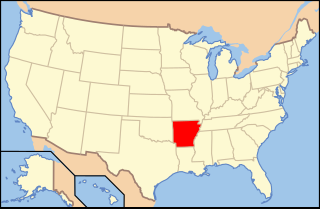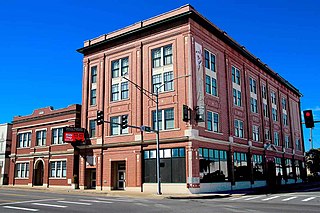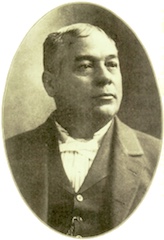
Scipio Africanus Jones was an American educator, lawyer, judge, philanthropist, and Republican politician from the state of Arkansas. He was most known for having guided the appeals of the twelve African-American men condemned to death after the Elaine Massacre of October 1919. More than one hundred African Americans were indicted in the aftermath of the riot, although an estimated one hundred to two hundred Black Americans were killed in the county, along with five whites. No whites were prosecuted by the state. The case was appealed to the United States Supreme Court, which in Moore v. Dempsey (1923) set a precedent of reviewing the conduct of state criminal trials against the Due Process Clause of the Fourteenth Amendment to the United States Constitution.

The Old State House, formerly called the Arkansas State House, is the oldest surviving state capitol building west of the Mississippi River. It was the site of the secession convention, as well as the fourth constitutional convention when delegates agreed to ensure voting rights for freedmen and establish public education.

Central Arkansas, also known as the Little Rock metro, designated by the United States Office of Management and Budget as the Little Rock-North Little Rock-Conway Metropolitan Statistical Area, is the most populous metro area in the U.S. state of Arkansas. With an estimated 2020 population of 748,031, it is the most populated area in Arkansas. Located at the convergence of Arkansas's other geographic regions, the region's central location make Central Arkansas an important population, economic, education, and political center in Arkansas and the South. Little Rock is the state's capital and largest city, and the city is also home to two Fortune 500 companies, Arkansas Children's Hospital, and University of Arkansas for Medical Sciences (UAMS).

Little Rock is the capital and most populous city of the U.S. state of Arkansas. The city's population was 204,405 in 2022, according to the United States Census Bureau. As the county seat of Pulaski County, the city was incorporated on November 7, 1831, on the south bank of the Arkansas River close to the state's geographic center in Central Arkansas. The city derived its name from a rock formation along the river, named the "Little Rock" by the French explorer Jean-Baptiste Bénard de la Harpe in 1722. The capital of the Arkansas Territory was moved to Little Rock from Arkansas Post in 1821. The six-county Little Rock–North Little Rock–Conway, AR Metropolitan Statistical Area (MSA) is ranked 81st in terms of population in the United States with 748,031 residents according to the 2020 estimate by the United States Census Bureau.

Jenny Eakin Delony, also known as Jenny Eakin Delony Rice and Jenny Meyrowitz, (1866–1949) was an American painter and educator. She specialized in portraits of notable and historic figures in the United States, but also made miniature, landscape, wildlife, still life, and genre paintings. She was the founder of collegiate art education in Arkansas.

The culture of Arkansas is a subculture of the Southern United States that has come from blending heavy amounts of various European settlers culture with the culture of African slaves and Native Americans. Southern culture remains prominent in the rural Arkansas delta and south Arkansas. The Ozark Mountains and the Ouachita Mountains retain their historical mount. Arkansans share a history with the other southern states that includes the institution of slavery, the American Civil War, Reconstruction, Jim Crow laws and segregation, the Great Depression, and the Civil Rights Movement.
The following is a timeline of the history of the city of Little Rock, Arkansas, USA.

The Harvey B. Gantt Center for African-American Arts + Culture, formerly known as the Afro-American Cultural Center, is in Charlotte, North Carolina and named for Harvey Gantt, the city's first African-American mayor and the first African-American student at Clemson University. The 46,500 sq ft, four-story center was designed by Freelon Group Architects at a cost of $18.6 million — and was dedicated in October 2009 as part of what is now the Levine Center for the Arts.

The Division of Arkansas Heritage (DAH) is a division of the Arkansas Department of Parks, Heritage, and Tourism of the U.S. State of Arkansas responsible for preserving, promoting, and protecting Arkansas's natural and cultural history and heritage. It was known as the Department of Arkansas Heritage until it was merged with the Arkansas Department of Parks and Tourism (ADPT) on July 1, 2019, becoming a division of ADPT's successor, the Arkansas Department of Parks, Heritage, and Tourism.

Originally known as Taborian Temple, the building was constructed in 1916 by the Arkansas chapter of the Knights and Daughters of Tabor when the 9th street area of Little Rock, Arkansas was a major hub of African-American commerce.

John M. Lewellen was an American politician. He was elected and served on the Little Rock City Board of Directors, the Pulaski County Quorum Court and in the Arkansas State Legislature representing the district in which he resided. He was a member of the Arkansas House of Representatives from 1999 to 2004, when he was succeeded by his wife, Wilhelmina Lewellen who served until 2010. John Lewellen is the only Arkansas official to have been elected and represented his district on the city, county and state level.

The Mosaic Templars of America was a black fraternal order founded by John E. Bush and Chester W. Keatts, two former slaves, in Little Rock, Arkansas, in 1883. The organization originally provided illness, death, and burial insurance during an era when few basic services were available to black people.
John Edward Bush (1856-1916) was the co-founder of the Mosaic Templars of America.

Chester W. Keatts (1854–1908), a former slave, co-founded the Mosaic Templars of America in Little Rock, Arkansas. He worked for the railway mail service, federal court, and as a lawman. He campaigned for two offices as a member of the Republican Party and initially received the majority of votes, but was not formally elected due to ballot interference by the Democrats.
Angela Davis Johnson is a community-informed, interdisciplinary artist who migrates between Philadelphia, Atlanta, New Orleans, and Arkansas. Her work is rooted in the traditions of Black people in what’s known today as the United States American South and is inspired by the collective ancestral memory of the entire African Diaspora. Davis Johnson uses archival images, acrylic and oil paint, found objects, bluing, fabric, beads, strings, hums, fragments of song and poetry, body movement, and gestures to bridge the happenings of the past, present, and future. Her work has been featured in the New York Times and has exhibited in galleries and museums, including Crystal Bridges Museum of Art, Mississippi Museum of Art, and the Mosaic Templars Cultural Center.

The Mosaic Templars State Temple is a historic African-American fraternal benefit society building at 906 South Broadway Street in Little Rock, Arkansas. It is a two-story masonry structure, built of brick and terra cotta. The front facade is symmetrical, with ornately decorated elements rising to a parapet. It was built in 1921 to house the headquarters of the state chapter of the Mosaic Templars of America, an African-American fraternal society founded by former slaves after the American Civil War. The building was part of a complex which originally included three buildings, one of which was the organization's national headquarters; the other two buildings were destroyed by fire.
John Carter was an African-American man who was murdered in Little Rock, Arkansas, on May 4, 1927. Grabbed by a mob after another Black man had been apprehended for the alleged murder of a white girl, Carter was hanged from a telephone pole, shot, dragged through the streets, and then burned in the center of the city's Black part of town with materials that a white crowd of perhaps 5,000 people had looted from nearby stores and businesses.
West Ninth Street was a former street area in West Little Rock, Arkansas. Although the former Black Business District and Neighborhood does not exist today, its history still survives throughout many research initiatives and the efforts of the Mosaic Templars Cultural Center, which is located in the former district.

African Americans have played an essential role in the history of Arkansas, but their role has often been marginalized as they confronted a society and polity controlled by white supremacists. During the slavery era to 1865, they were considered property and were subjected to the harsh conditions of forced labor. After the Civil War and the passage of the 13th, 14th, and 15th Reconstuction Amendments to the U.S. Constitution, African Americans gained their freedom and the right to vote. However, the rise of Jim Crow laws in the 1890s and early 1900s led to a period of segregation and discrimination that lasted into the 1960s. Most were farmers, working their own property or poor sharecroppers on white-owned land, or very poor day laborers. By World War I, there was steady emigration from farms to nearby cities such as Little Rock and Memphis, as well as to St. Louis and Chicago.
















